The KV-1 Heavy Tank
This Soviet WW2 KV-1 Heavy Tank can be found at the Tank Museum, Bovington, Dorset, England. It was supplied to Britain by the Soviets in the summer of 1942 along with a T-34 tank. A similar pair were sent to America at the same time do that their allies could assess its mechanical and fighting characteristics. It is a later production model and has additional armour plating fitted. The turret was now cast rather than welded. It has a longer barreled 76mm F-34 gum which was later changed to the 76.2 mm ZiS-5 tank gun. It was manufactured in Chelyabinsk (Tankograd) in the Urals. Post war it was given the designation KV-1B to distinguish it from all the other KV-1 tanks but the Soviet Army only called it the KV-1 tank not the KV-B.
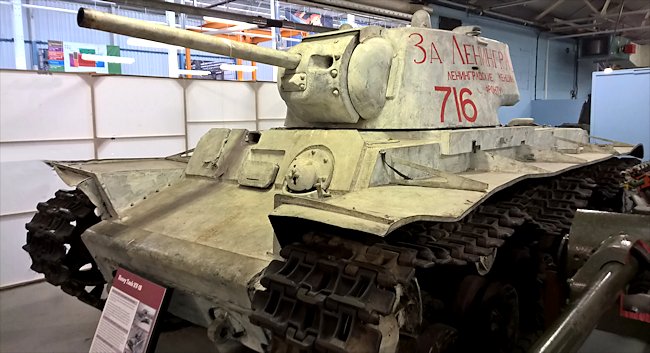
Red Army WW2 KV-1 Tank, displayed in winter whitewash camouflage, at the Tank Museum, Bovington.
In December 1941 the Soviet commander of a KV-1 equipped armoured battalion, First Lieutenant Khorin received an order to liberate the village of Nafedyevo and destroy the occupying German tanks. But how was he going to execute his order? After weeks of bitter fighting and bad winter conditions he was only left with two combat worthy tanks.
He had to keep one in reserve so he gave an order to one of the KV-1 tank commanders, Lieutenant Pavel Groudz, to move towards the village and find a good hull down position by the morning. The tank reached the river that ran through the village at night, under the cover of artillery fire. At dawn, it opened direct fire against German armoured vehicles, much to their surprise. Eight German tanks were knocked out in the first minutes of the battle and a further two tanks were successfully knocked out once the river had been forged.
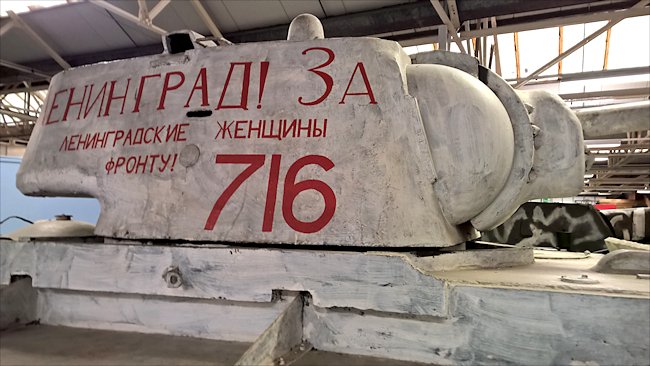
The slogan on the KV-1 tank turret reads 'From the women of Leningrad to the Front'
After the battle tank crew inspected the damage on their KV-1. They counted twenty-nine hits by enemy shells on their armour not a single German round penetrated its armour. It was a very strong tank. That is how an entire village was freed with the help of just one KV-1 tank.
At the end of the 1930s a new heavy tank design was presented in front of the Soviet Union high command. It was designed to replace the T-35 tank. This huge five turret monster, based on a British design, had a number of faults. The most problematic was that where the curvature of the turrets met the hull, shell traps were formed. Incoming enemy shells were not deflected away from the vehicle but instead assisted in finding a point penetration.
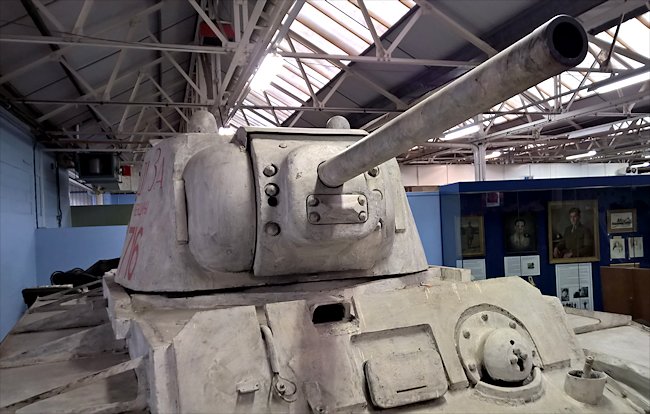
Red Army WW2 KV-1 Tanks were armed with a powerful 76.2mm gun
Soviet tank designers started work to design a better tank that could cope with the Soviet terrain, be easy to produce, and have a good chance of surviving a gunfight with German tanks. The first prototype was a modernisation of the T-35 tank but it wasn’t successful. Three totally new designs were produced. They went to trials in 1939 and were known as the T-100, SMK (CMK) and KV (KB-1). First two tank designs featured two turrets; one was placed on top of the hull in the centre and the second was mounted higher up behind first turret.
The KV tank created under the management of Zhozef Kotin and Nikolay Dukhov, had a different layout. The design called for only one larger turret that had two cannons installed side-by-side. After trials the KV tank was chosen because of its lower profile which made it harder to be seen and therefore targeted by the enemy. The KV tank was also lighter by 15 tonnes than the T-100 and SMK prototypes. This made the KV tank easier to transport by the railway network, especially over bridges with limited cargo weight capacity.
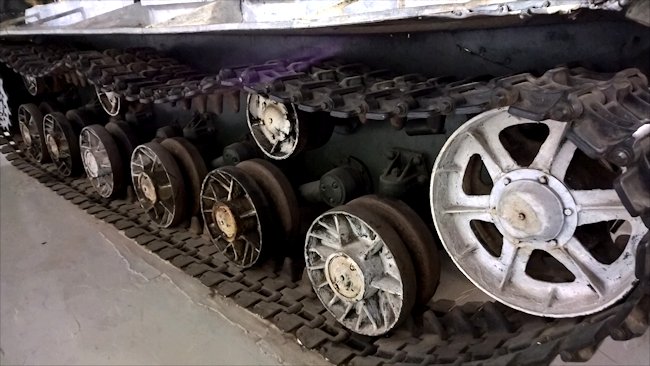
The suspension, road wheels and wide track on a KV-1 tank
Orders were given to start mass producing the KV tank but we one alteration, it would only have one gun fitted to the turret. It was found that two guns restricted the tank crew’s actions inside the fighting compartment resulting in poor performance during battlefield trials.
When the tank was introduced into Soviet service it was given the designation KV-1. The letters stood for Klim Voroshilov. It had a combat weight of 47 tons, a five-man crew and was armed with a 76.2mm cannon and three 7.62mm machine guns. The tanks engines could produce 600 hp which gave a maximum road speed of 34 km/h (21 mph)
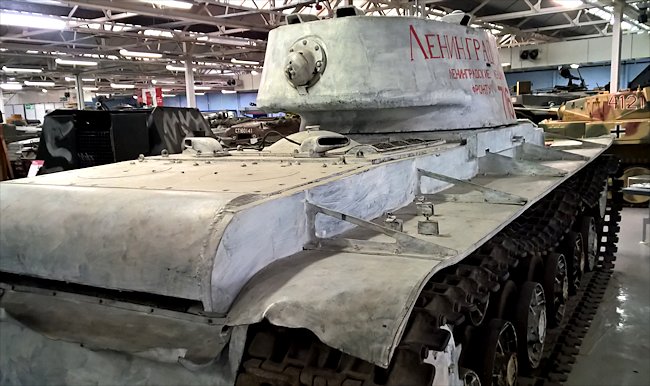
Notice the machinegun in the rear of the turret on this KV-1 Tank
The KV-1 tank received its first baptism of fire in December 1939 in the winter war with Finland. All the advantages and problems of this new combat vehicle soon became apparent during this campaign. The heavy armour on this new vehicle proved more than adequate against the anti-tank weapons of the enemy. However the tank’s gun proved ineffective against reinforced concrete pillboxes.
A more powerful weapon system in the form of a howitzer gun was urgently developed. The new 152mm howitzer gun was fitted inside a new turret on top of the KV tank. This vehicle became the KV-2. They were called up to provide support for infantry regiments and tanks when strong enemy fortifications were encountered.
Production of the KV heavy tanks was organised at the beginning of 1940 at the Kirovisky Works in Leningrad. When the Germans first invaded Russia, three hundred and seventy KV-1 and one hundred and forty KV-2 tanks have been produced. This was not a huge number compared with later production figures.
These new tanks presented a serious danger to the invading German divisions. Many of the shells fired from the guns fitted to their Panzer mark III and IV tanks just bounced off these new Russian heavyweight monsters. The only effective way the Germans had of knocking out a KV tank in 1941 and 1942 was from a well-aimed 88 mm anti-aircraft gun, artillery bombardment or Luftwaffe bombing.
Some German reports have been found that state infantry units had managed to knock out a few of these new tanks by climbing onto the back of the tank, pouring petrol over the transmission and engine hatches and using grenades in the same location.
Production of the KV-2 tank stopped after the beginning of the war with Germany, but those few that have been manufactured played a significant role on the battlefield. All the production power of the factories went into producing the KV-2 heavy tank. Production of combat vehicles in cities close the front line was causing problems. Supplies of materials and parts had problems getting through to the factories because of congested roads and continual bombardment.
The Russian Tank designers continually made alterations to the vehicle specifications. By July 1941 KV-1 tanks were rolling off the production line with the increased armour protection. The problem is this had a negative effect on the tank’s mobility and reliability because of the extra weight. The gearbox and clutch quickly wore out and couldn’t cope with the additional strain.
In October 1941 the production of the KV-1 tanks in Leningrad was stopped and moved hundreds of miles east to the Urals. It wasn’t until 1943 and the appearance of the German Tiger tank, followed later by the Panther tank, that the KV-1 tank was finally outclassed. The Soviet army took the decision to introduce a new heavy tank to replace the KV series of tanks. The new tanks were named after Joseph Stalin and given the designation of IS-1.
WW2 tank books

